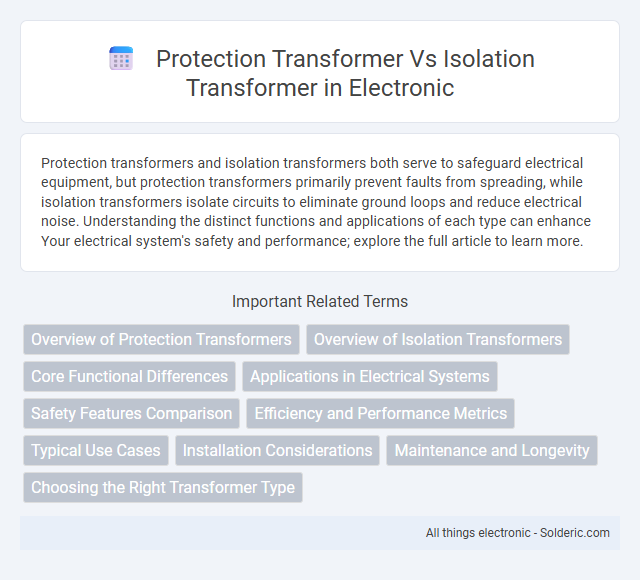Protection transformers and isolation transformers both serve to safeguard electrical equipment, but protection transformers primarily prevent faults from spreading, while isolation transformers isolate circuits to eliminate ground loops and reduce electrical noise. Understanding the distinct functions and applications of each type can enhance Your electrical system's safety and performance; explore the full article to learn more.
Comparison Table
| Feature | Protection Transformer | Isolation Transformer |
|---|---|---|
| Primary Purpose | Protects equipment from overload and short circuits | Electrically isolates primary and secondary circuits to prevent shock |
| Electrical Isolation | Partial or none | Complete isolation between input and output |
| Usage | Motor protection, overload protection in power systems | Medical equipment, sensitive electronics, noise reduction |
| Voltage Regulation | Provides voltage step-down or step-up with protection | Maintains same voltage level with isolation |
| Safety Benefits | Prevents damage from electrical faults | Prevents electric shock and reduces electrical noise |
| Typical Construction | May have taps, fuses, or circuit breakers | Standard transformer windings physically separated |
Overview of Protection Transformers
Protection transformers are designed to shield sensitive equipment from voltage spikes, electrical noise, and faults by providing galvanic isolation and voltage regulation. They feature robust insulation and surge suppression components to minimize the risk of electrical damage in industrial and commercial applications. Unlike isolation transformers, protection transformers often include built-in protective elements such as fuses and thermal cutouts to enhance system safety and reliability.
Overview of Isolation Transformers
Isolation transformers provide electrical isolation between the primary and secondary windings, ensuring that your equipment is protected from electric shocks and voltage spikes. Unlike protection transformers that primarily serve to limit fault currents, isolation transformers block noise and transients while maintaining signal integrity. Their design helps improve safety and reliability in sensitive electronic applications by decoupling the power source from the load.
Core Functional Differences
Protection transformers primarily serve to shield sensitive equipment from electrical faults by limiting fault currents and voltage surges, while isolation transformers isolate the load from the power source, breaking direct electrical connections to prevent ground loops and noise interference. The core of a protection transformer is designed to handle fault conditions with robust insulation and enhanced thermal stability, whereas the isolation transformer features a magnetic core optimized for minimizing electromagnetic interference (EMI) and providing galvanic isolation. These fundamental differences impact their application in electrical systems, with protection transformers used for safeguarding circuits and isolation transformers for ensuring signal integrity and operator safety.
Applications in Electrical Systems
Protection transformers are primarily used in electrical systems to shield equipment from voltage spikes, surges, and transient disturbances, ensuring safety and preventing damage in sensitive circuits. Isolation transformers serve critical roles by electrically separating primary and secondary circuits, which enhances safety by eliminating ground loops and reducing electrical noise in control systems and medical devices. Your choice between protection and isolation transformers should consider the specific application requirements, such as voltage regulation needs and the level of electrical isolation necessary for system integrity.
Safety Features Comparison
Protection transformers incorporate built-in fuses and overload sensors to prevent electrical faults and enhance user safety, making them ideal for safeguarding sensitive equipment. Isolation transformers provide galvanic isolation by separating input and output circuits, significantly reducing the risk of electric shocks and ground loop interference. Both types prioritize safety, but isolation transformers excel in eliminating direct electrical connection risks, whereas protection transformers focus on fault detection and current limitation.
Efficiency and Performance Metrics
Protection transformers typically exhibit higher efficiency due to their design focused on minimizing energy loss during voltage regulation and fault conditions. Isolation transformers prioritize safety by providing galvanic isolation and may have slightly lower efficiency because of additional winding insulation and core construction tailored for noise reduction and surge protection. Performance metrics such as voltage regulation, waveform distortion, and thermal stability are generally better optimized in protection transformers to ensure continuous operation under fault scenarios, while isolation transformers excel in reducing electromagnetic interference and ensuring operator safety.
Typical Use Cases
Protection transformers are typically used in electrical systems to safeguard sensitive equipment from voltage spikes, surges, and noise by providing voltage regulation and transient suppression. Isolation transformers are commonly employed in medical equipment, industrial control systems, and laboratory instruments to prevent electric shock and eliminate ground loops by electrically separating the input and output circuits. Choosing the right transformer for your application depends on whether you need primarily surge protection or complete electrical isolation for enhanced safety and noise reduction.
Installation Considerations
Protection transformers require careful grounding and surge protection measures during installation to safeguard sensitive equipment from voltage spikes and electrical noise. Isolation transformers must be installed with attention to maintaining electrical separation between input and output circuits to prevent inadvertent ground loops and ensure safety compliance, often necessitating dedicated mounting space and clear labeling. Both transformer types benefit from proper ventilation and adherence to manufacturer specifications to optimize performance and longevity.
Maintenance and Longevity
Protection transformers require regular maintenance to monitor insulation condition and winding integrity, ensuring reliable operation over time. Isolation transformers typically boast enhanced durability due to their robust design and fewer moving components, which can extend their longevity with minimal intervention. Your choice between the two should consider the maintenance schedule and expected lifespan based on the specific application requirements.
Choosing the Right Transformer Type
Choosing the right transformer type depends on the specific application and safety requirements; protection transformers are designed to prevent electrical faults and ensure safe operation by limiting fault currents, while isolation transformers provide galvanic isolation to eliminate ground loops and protect sensitive equipment from voltage spikes. Protection transformers are ideal for systems requiring enhanced fault tolerance and operational safety, whereas isolation transformers are essential in environments where electrical noise reduction and equipment protection from transient voltages are critical. Evaluating factors such as load characteristics, environmental conditions, and regulatory standards will guide the selection between protection and isolation transformers.
protection transformer vs isolation transformer Infographic

 solderic.com
solderic.com